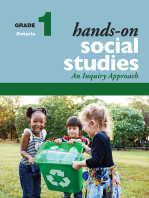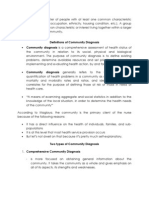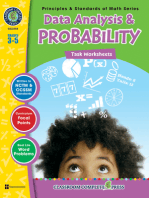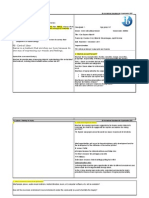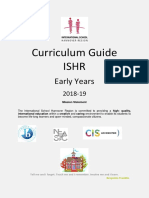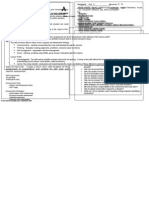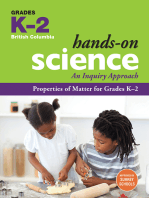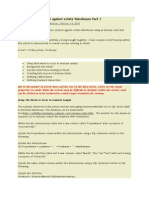Bha Maths POI
Bha Maths POI
Uploaded by
Dave SecombCopyright:
Available Formats
Bha Maths POI
Bha Maths POI
Uploaded by
Dave SecombOriginal Description:
Copyright
Available Formats
Share this document
Did you find this document useful?
Is this content inappropriate?
Copyright:
Available Formats
Bha Maths POI
Bha Maths POI
Uploaded by
Dave SecombCopyright:
Available Formats
Number
Numbers
JKP
Central
idea:
Lines of
Inquiry:
JK
Central
idea:
Lines of
Inquiry:
G1
One to one
correspondence.
The language of
mathematics.
other through a
variety of
relationships
The relevant
magnitude of
whole numbers.
Combining and
partitioning.
Quantity.
Making
connections
between our
experiences with
number can help to
develop number
sense.
Conservation of
number.
Whole-part
relationships
Estimating
quantities to 100 or
beyond.
Central
idea:
Lines of Strategies for
Data Handling
Chance
Data
Data explored
through emergent
experiences and
units of inquiry.
Language used to describe position
and direction.
Shapes can be described and
organized.
Language of
chance explored
through emergent
experiences and
units of inquiry.
The characteristics of 2D and 3D
shapes.
Explore fractions
through emergent
experiences (built
through all strands)
to represent
numbers and
number
relationships.
The base-10
number system to
100s.
Addition and
subtraction of
whole numbers.
The language of
addition and
subtraction.
The four operations
are used to process
information and
solve problems.
Shape and Space
Shape
Space
Objects in our environment have a
position that can be described.
Central The base-10 place
value system is used
idea:
Lines of
Inquiry:
G2
Numbers are a
naming system.
Numbers are
Central
connected
to each
idea:
Lines of
Inquiry:
SK
Fractions
Fractions represent
whole-part
relationships.
Fraction
Organizing objects
and events helps us
to solve problems.
Sorting and
classifying
objects.
We collect
information to
make sense of the
world around us.
Shapes are made up of parts that repeat
in some way.
Events in daily life
involve chance.
The relationships between and among
2D and 3D shapes.
Constructing and deconstructing 2D
and 3D shapes.
Symmetry, tessellation and
transformation.
The language of
probability (never,
sometimes,
always).
The attributes
used to organize
sets.
Questioning and
interpreting data.
Shapes are
classified according
to their properties.
Language can be
used to describe
an objects
position in space.
Some events in daily
life are more likely to
happen than others.
Data can be
organized in
different ways.
Sorting,
describing and
classifying shapes.
Real world
representation of
shapes.
The language of
direction.
How direction
and position are
used to find
locations and
objects.
Chance in daily
life (impossible, less
likely, maybe,
more likely,
certain).
Manipulatives that
help to explore
chance.
Shapes can be manipulated in different
ways.
Reflective and rotational symmetry.
Probability can be
based on
experimental
events.
Experimental
Ways of
representing
data.
How data is
collected.
Data can be
collected,
organized,
displayed and
analyzed in
different ways.
Ways of
Measurement
Measurement
Time
Objects have
attributes that can
be compared.
Language used
to describe
objects.
Attributes of
objects.
Language of time
explored through
emergent
experiences and
units of inquiry.
Measurement involves comparing and
ordering objects and events.
Language used to describe events.
The comparison and ordering of objects
from daily life (e.g. long/short;
heavy/light; empty/full; hot/cold).
Objects have
attributes that can
be measured.
Measurement
using standard
and nonstandard units.
Tools used to
measure length.
Events can be
ordered and
sequenced.
Describing and
sequencing
events in daily
life.
Calendars as a
tool to identify
and sequence
time.
We use tools to measure the attributes of
objects and events.
Tools that can be used to measure
objects and events.
The standard units used to measure
time, money, length, capacity, mass
and temperature.
Recording and describing
measurement.
Estimation allows us
to measure with
different levels of
accuracy.
Standard units
allow us to
compare, order
and sequence
objects and events.
Uses and
Standard units
Pattern and Function
Patterns and sequences occur in
everyday situations.
Patterns in nature and the learning
environment.
Patterns repeat and grow.
The recording of patterns.
How and why patterns grow.
Patterns can be represented using
numbers and other symbols.
Patterns in numbers.
The use of symbols to create and
represent patterns.
Number patterns can be observed and
described.
Relationships between addition and
subtraction.
Associative and commutative
properties of addition.
Functions are useful for examining
relationships between sets of data.
Different ways of representing functions.
Inquiry:
G3
Central
idea:
memorizing
number facts.
Estimating sums
and differences.
relationships.
Addition and
subtraction of
fractions.
Number operations
can be modeled in
a variety of ways.
Fractions and
decimals represent
whole-part
relationships.
Lines of Multiplication and
Inquiry: division of whole
Decimal fractions.
Equivalent
fractions.
Addition and
subtraction of
fractions and
decimals.
Central
idea:
Fractions, decimals
and percentages
are ways of
representing
whole-part
relationships.
The relationship
between
fractions,
decimals and
percentages.
Improper
fractions and
mixed numbers.
numbers.
Numbers to 1000s
and beyond.
The language of
multiplication and
division.
G4
The base-10 place
value system
extends infinitely in
two directions.
Lines of Numbers to
Inquiry: millions or beyond.
Operations
involving all
integers.
G5
Central
idea:
Ratios are an
effective way of
conveying
information.
Lines of Number ratios
Inquiry: used in daily life.
The use of ratios to
solve real life
problems.
For fractional and
decimal
computation, the
ideas developed
for whole-number
computation can
apply.
Addition,
subtraction,
multiplication and
division of
fractions and
decimals.
Simplifying
fractions.
Congruency.
The relationship between coordinates,
direction and location.
Changing the position of a shape does
not alter its properties.
Sorting and classifying angles.
The properties of regular and irregular
polygons (including circles, triangles
and quadrilaterals).
events involving
chance.
Fair and unfair
situations.
Recording and
predicting
experimental trials.
Probability can be
expressed in
numbers.
Expressing
probability using
fractions.
Representing
probability
graphically.
Probability as a tool
to explain possible
outcomes.
Geometric tools and methods can be
used to solve problems relating to shape
and space.
Probability can be
predicted
theoretically.
The properties of regular and irregular
polyhedral.
Systems for describing position and
direction.
How to use geometric tools (protractor,
compass, ruler).
The differences
between
experimental and
theoretical
probability.
Dependent and
independent
probability.
Geometric concepts allow us to make
sense of and interact with our world.
How we use geometric ideas and
relationships to solve problems.
How scale is used to enlarge and
reduce shapes.
collecting and
recording data.
Ways to display
data.
How to use data
to make
predictions.
Different graph
forms highlight
different aspects of
data more
efficiently.
How scale is used
in graphs.
Different types of
graphs.
Selecting
appropriate
graphs for given
data.
Data can be
presented
effectively for valid
interpretation and
communication.
The role and
purpose that
different graphs
have.
Factors that affect
data quality.
Evaluation of the
effectiveness of
data.
Representing
probability on a
scale helps to solve
problems.
Range, mode,
median and mean
can be used to
analyze statistical
data.
Ways of expressing
the likelihood of
events (e.g. scale,
percentage and
ratio).
Calculating,
comparing and
using probability in
operations.
Summarizing data
using mean,
mode, median
and range.
How databases
are used to
answer questions
and solve
problems.
purposes of
estimation in
measurement.
Estimation as a
problem-solving
tool.
used to measure
time.
The relationship
between units of
time.
Functions as a tool to describe rules.
Objects and events have attributes that
can be measured using appropriate tools.
Identifying rules for patterns allows us to
make predictions.
Measures that fall between numbers on
a scale.
Angles as a measure of rotation.
Comparing and converting AM/PM and
24 hour time systems.
Relationships between multiplication
and division.
How rules are used to make predictions.
Associative and commutative properties
of multiplication.
Relationships exist
between standard
units that measure
the same attributes.
Time provides a
way of ordering
and organizing
past, present and
future.
Relationships
between
area/perimeter;
area/volume;
volume/capacity.
Relationships
between metric
units.
Patterns found in
time.
Ways to represent
time.
How timelines
allow us to order
and arrange
events.
Accuracy of
measurement
depends on the
situation and the
precision of the
tool.
Procedures for
finding area,
perimeter and
volume.
Unit conversions
within and
between
measurement
systems.
Justification of the
level of accuracy
required to solve
problems.
A range of
procedures exist to
measure events.
Calculating
elapsed time.
Determining time
worldwide.
Patterns can be generalized using
algebraic expressions, equations or
functions.
Methods used to analyze patterns and
identify rules.
How rules are represented using
algebraic expressions.
The use of rules to solve problems and
make predictions.
Exponential notation is a powerful way to
express repeated products of the same
number.
Exponents as repeated multiplication.
The inverse relationship between
exponents and roots.
You might also like
- Evaluation Methods For Studying Programs and Policies - Carol H. WeissDocument384 pagesEvaluation Methods For Studying Programs and Policies - Carol H. Weissjavielcabrero100% (7)
- Hands-On Social Studies for Ontario, Grade 1: An Inquiry ApproachFrom EverandHands-On Social Studies for Ontario, Grade 1: An Inquiry ApproachNo ratings yet
- Kinder Where We Are in Place and Time Sy14-15Document7 pagesKinder Where We Are in Place and Time Sy14-15api-256382279100% (3)
- PYP Exhibition Manual PDFDocument38 pagesPYP Exhibition Manual PDFHansIsaiahWongNo ratings yet
- How We Organize Ourselves Grades 3 4 Sy 2012-2013Document7 pagesHow We Organize Ourselves Grades 3 4 Sy 2012-2013api-264373083100% (2)
- Causation Change Perspective: Human Migration Is A Response To Circumstances, Challenges and OpportunitiesDocument3 pagesCausation Change Perspective: Human Migration Is A Response To Circumstances, Challenges and Opportunitiesasima100% (2)
- Grade 2 - WWAPT-Unit PlannerDocument5 pagesGrade 2 - WWAPT-Unit PlannerranaNo ratings yet
- How We Organize OurselvesDocument5 pagesHow We Organize OurselvesPushpita Nandy100% (1)
- 2011-2012 PYP PlannerDocument4 pages2011-2012 PYP Plannertyas24100% (2)
- Sample1.1 - en P or Y1Document4 pagesSample1.1 - en P or Y1Elena BajanNo ratings yet
- How The World Works-Pyp 3Document3 pagesHow The World Works-Pyp 3api-253737767No ratings yet
- Unit 5 Letter How We Express Ourselves kg2Document5 pagesUnit 5 Letter How We Express Ourselves kg2api-24590655975% (4)
- Planning Where We Are in Place and Time Grade 3 4Document4 pagesPlanning Where We Are in Place and Time Grade 3 4api-32588973280% (10)
- My PYP Classroom Checklist: EveryDocument2 pagesMy PYP Classroom Checklist: Everyami1967100% (1)
- A Community Is A Cluster of People With at Least One Common CharacteristicDocument7 pagesA Community Is A Cluster of People With at Least One Common CharacteristicWilliam Ezekiel JUju CustodioNo ratings yet
- How We Express Ourselves 1 17 13Document4 pagesHow We Express Ourselves 1 17 13api-147600993100% (1)
- Government Y6 PYP Planner Summer 1 2012Document4 pagesGovernment Y6 PYP Planner Summer 1 2012GEETHA NARAYANAN HOMEROOM - PRIMARY-SLM-MAINNo ratings yet
- Pyp Exhibition Orientation For StudentsDocument10 pagesPyp Exhibition Orientation For Studentsapi-234755766100% (1)
- 9 Stage Planner Gr4 How We Organise OurselvesDocument4 pages9 Stage Planner Gr4 How We Organise OurselvesRaj Kumar MNo ratings yet
- How We Organize Ourselves UOI CommentsDocument5 pagesHow We Organize Ourselves UOI CommentsShuvraSheulyRoyNo ratings yet
- Unit 2 - Where We Are in Place and TimeDocument11 pagesUnit 2 - Where We Are in Place and Timesathya karunakaranNo ratings yet
- Who We Are (Relationships) 2018 - 2019 PDFDocument8 pagesWho We Are (Relationships) 2018 - 2019 PDFKirtika Mehta100% (1)
- Enhanced Planner Where We Are in Place and TimeDocument16 pagesEnhanced Planner Where We Are in Place and Timeasima100% (4)
- Planning Where We Are in Place and Time Grade 3 4 PDFDocument4 pagesPlanning Where We Are in Place and Time Grade 3 4 PDFKunal SinghNo ratings yet
- G1 PE How We Express Ourselves 122345Document4 pagesG1 PE How We Express Ourselves 122345Jaydil Hermias100% (1)
- How We Express Ourselves RevisedDocument1 pageHow We Express Ourselves RevisedMariana SuarezNo ratings yet
- Pyp 5 Unit 3 NewsletterDocument4 pagesPyp 5 Unit 3 Newsletterapi-516787540100% (1)
- How We Organize OurselvesDocument5 pagesHow We Organize Ourselvesapi-313149236No ratings yet
- How We Organize Ourselves Parent Letter 2011Document2 pagesHow We Organize Ourselves Parent Letter 2011eokuceraNo ratings yet
- Place and Time A3 PYP Planner in ProgressDocument4 pagesPlace and Time A3 PYP Planner in Progresstime space education100% (4)
- Learning Through Inquiry LeafletDocument2 pagesLearning Through Inquiry Leafletmusic23No ratings yet
- Unit 4 Letter Where We Are in Place and Time kg2Document6 pagesUnit 4 Letter Where We Are in Place and Time kg2api-265244171No ratings yet
- Curriculum Guide ISHR Early Years 2018 - 19Document24 pagesCurriculum Guide ISHR Early Years 2018 - 19Manju NndhiNo ratings yet
- Where We Are in Place and Time: Unit LetterDocument2 pagesWhere We Are in Place and Time: Unit LetterJenny Fenton100% (2)
- 2 - How We Express Ourselves StorytellingDocument2 pages2 - How We Express Ourselves StorytellingMariam BazerbachiNo ratings yet
- Lesson Plan - How We Express OurselvesDocument16 pagesLesson Plan - How We Express OurselvesnehaNo ratings yet
- Where We Are in Place and TimeDocument1 pageWhere We Are in Place and TimeMariana Suarez100% (1)
- How We Express Ourselves RevisedDocument1 pageHow We Express Ourselves RevisedMariana SuarezNo ratings yet
- How We Express Ourselves 1 17 2013Document4 pagesHow We Express Ourselves 1 17 2013api-147600993100% (1)
- Sharing The Planet PYP Planner ScienceDocument4 pagesSharing The Planet PYP Planner ScienceDanielRobertson0% (1)
- How We Organize Ourselves: 1. What Is Our Purpose?Document6 pagesHow We Organize Ourselves: 1. What Is Our Purpose?rana100% (1)
- Observation 3 Lesson PlanDocument3 pagesObservation 3 Lesson Planapi-348449379No ratings yet
- ICT Unit Planner - Year 3 Sharing The PlanetDocument1 pageICT Unit Planner - Year 3 Sharing The Planetdanny67% (3)
- 1st Uoi Planner Where We Are in Place and Time 2010 2011 NewDocument4 pages1st Uoi Planner Where We Are in Place and Time 2010 2011 NewAlka SaxenaNo ratings yet
- 4th Grade Reflection For Sharing The PlanetDocument3 pages4th Grade Reflection For Sharing The PlanetKristin CramerNo ratings yet
- PYP III Daily Lesson Planner Friday 2Document3 pagesPYP III Daily Lesson Planner Friday 2Sundas Ansari100% (1)
- Unit 5 How The World Works Grades 3 4 Sy 2013-2014Document7 pagesUnit 5 How The World Works Grades 3 4 Sy 2013-2014api-264373083No ratings yet
- 2020-21 Kramer Pre-K Who We AreDocument12 pages2020-21 Kramer Pre-K Who We AreDavyMa100% (2)
- Sample Unit Planner For The ArtsDocument4 pagesSample Unit Planner For The Artsapi-261132454100% (1)
- Who We Are Grade 4 2013-2014Document9 pagesWho We Are Grade 4 2013-2014api-264373083No ratings yet
- Unit 4 Letter Where We Are in Place and Time kg2Document6 pagesUnit 4 Letter Where We Are in Place and Time kg2api-245906559100% (1)
- Unit 4 - Where We Are in Place and Time (OK) (S) (SS)Document5 pagesUnit 4 - Where We Are in Place and Time (OK) (S) (SS)Pushpita NandyNo ratings yet
- Report PYPDocument7 pagesReport PYPHeryien Salim100% (2)
- Sharing The Planet NewsletterDocument1 pageSharing The Planet NewslettermruokanenNo ratings yet
- How We Express Ourselves NewsletterDocument2 pagesHow We Express Ourselves NewsletterNISTYear1No ratings yet
- PYP 6 Who We Are NewsletterDocument3 pagesPYP 6 Who We Are NewsletteryanyuliusNo ratings yet
- Properties of Matter for Grades K-2: An Inquiry ApproachFrom EverandProperties of Matter for Grades K-2: An Inquiry ApproachNo ratings yet
- PYP For New ParentsDocument23 pagesPYP For New ParentsDave Secomb100% (2)
- G5 HTWWDocument1 pageG5 HTWWDave SecombNo ratings yet
- A21CS Assignment 1Document3 pagesA21CS Assignment 1Dave SecombNo ratings yet
- The Giant of JejuDocument2 pagesThe Giant of JejuDave SecombNo ratings yet
- Pgdca Office Automation & Tally PracticalDocument14 pagesPgdca Office Automation & Tally PracticalPrince ChandraNo ratings yet
- Note Buad806 Mod1 3buhumcr6wxmrreDocument251 pagesNote Buad806 Mod1 3buhumcr6wxmrreAdetunji Babatunde TaiwoNo ratings yet
- AshlandDocument3 pagesAshlandAloma100% (1)
- HANA Administration For SAP BasisDocument171 pagesHANA Administration For SAP BasisNizam100% (1)
- Chapter IvDocument10 pagesChapter IvJohn Mark Fernandez DanlagNo ratings yet
- Pulse - Sense - Evolve: Introductory HandbookDocument18 pagesPulse - Sense - Evolve: Introductory HandbookMarius BuneaNo ratings yet
- Group 5 Project TitleDocument4 pagesGroup 5 Project TitleYenew AyenewNo ratings yet
- GS1 XML Ecom Technical User Guide I1 PDFDocument27 pagesGS1 XML Ecom Technical User Guide I1 PDFSaskicNo ratings yet
- Computer Vision Literature ReviewDocument6 pagesComputer Vision Literature Reviewea8d1b6n100% (1)
- XOLAP - Virtual Cubes Against A Data Warehouse Part 1Document7 pagesXOLAP - Virtual Cubes Against A Data Warehouse Part 1parmitchoudhuryNo ratings yet
- UPK Math Section 8 Early Childhood Math Developmental ContinuumDocument18 pagesUPK Math Section 8 Early Childhood Math Developmental ContinuumMy NameNo ratings yet
- Certified List of Candidates: Iloilo - Estancia Iloilo - EstanciaDocument3 pagesCertified List of Candidates: Iloilo - Estancia Iloilo - EstanciaShello DesalesNo ratings yet
- Poster On Quantum ComputingDocument1 pagePoster On Quantum ComputingHarsha VardhanNo ratings yet
- Literature Review On Quantitative EasingDocument5 pagesLiterature Review On Quantitative Easingaflrrefsn100% (1)
- 3is Q2 Module 1.1Document23 pages3is Q2 Module 1.1Leonila Oca82% (11)
- Module 15: Siebel Analytics Applications OverviewDocument20 pagesModule 15: Siebel Analytics Applications OverviewDeepanshuNo ratings yet
- Assignment #3: A3 Memo Report: Explanation of TaskDocument3 pagesAssignment #3: A3 Memo Report: Explanation of TaskHamza HusnainNo ratings yet
- PACS Server Components: Merge Healthcare - ConfidentialDocument26 pagesPACS Server Components: Merge Healthcare - ConfidentialPrashantNo ratings yet
- Dsu5651 DS4 2023Document18 pagesDsu5651 DS4 2023Wijendra PushpanathanNo ratings yet
- ENOTE-Enabling DIP Switches On The QuickServerDocument12 pagesENOTE-Enabling DIP Switches On The QuickServerManutencao Dass ConfecçãoNo ratings yet
- A Framework of Business Intelligence Solution For Real Estates AnalysisDocument9 pagesA Framework of Business Intelligence Solution For Real Estates AnalysisJason XanderNo ratings yet
- SGU 2922 Methodology: Faculty of Geoinformation and Real Estate Universiti Teknologi MalaysiaDocument25 pagesSGU 2922 Methodology: Faculty of Geoinformation and Real Estate Universiti Teknologi MalaysiaCaley Jousie AminNo ratings yet
- Research Capability of Teachers: Its Correlates, Determinants and Implication For Continuing Professional DevelopmentDocument12 pagesResearch Capability of Teachers: Its Correlates, Determinants and Implication For Continuing Professional DevelopmentMark Anthony AgustinNo ratings yet
- Payroll Mass Upload User ManualDocument5 pagesPayroll Mass Upload User ManualTara Prasad MahapatraNo ratings yet
- Nursing AdministrationDocument6 pagesNursing AdministrationMary Anne YounghusbandNo ratings yet
- Exam Topics 1Z0-082Document12 pagesExam Topics 1Z0-082HARIPUSHP SHARMANo ratings yet
- Lazard Global Medical Devices Diagnostics and Tools Leaders Study 2023Document17 pagesLazard Global Medical Devices Diagnostics and Tools Leaders Study 2023YuqingNo ratings yet
- Assignmrnet 12Document2 pagesAssignmrnet 12hendra filianoNo ratings yet

